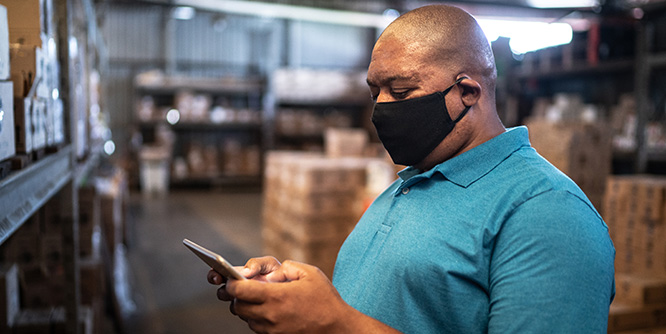
Photo: Getty Images/FG Trade
March 15, 2021
The next evolution of the supply chain will be all about visibility
PVH Corp., the parent of Calvin Klein and Tommy Hilfiger, is more highly prioritizing real-time inventory visibility to better adjust to potential disruptions coming out of the pandemic.
Eileen Mahoney, PVH’s CIO, told The Wall Street Journal, “It’s allowed the business to get a better handle on where demand is, where the consumer is shopping, and we’re now going to be nimble about where inventory is.”
A new report from the Capgemini Research Institute finds 66 percent of consumer products and retail (CP&R) organizations saying their supply chain strategies will change significantly in the next three years, with much of the attention on heightened visibility.
The supply chain realignment is expected to focus around three areas.
Demand sensing
Sixty-eight percent of CP&R organizations surveyed faced difficulties in demand planning due to a lack of accurate and up-to-date information on fluctuating customer demand during the pandemic. Two-thirds plan to segment supply chains according to demand patterns, product value and regional dimensions post pandemic, while 54 percent will use analytics/AI-machine learning for demand forecasting.
Visibility becomes critical
Facing difficulties quickly increasing or decreasing production capacity, 58 percent of retailers and 61 percent of consumer product organizations are planning to increase investments in digitization of supply chains to improve visibility. Forty-seven percent are planning to invest in automation, 42 percent in robotics and 42 percent in artificial intelligence. Sixty-four percent and 63 percent of organizations are also planning to make extensive use of artificial intelligence and machine learning across transportation and pricing optimization respectively.
From globalization to localization
Seventy-two percent of consumer product organizations and 58 percent of retailers are actively investing in regionalizing or localizing their manufacturing base or nearshoring production to prevent future disruption.
The study found respondents faced significant challenges across the supply chain in the wake of the crisis, including difficulties in end-to-end monitoring of the supply chain, cited by 72 percent; delayed shipments/longer lead times, 74 percent; and bottlenecks at ports or at borders, 68 percent.
Discussion Questions
DISCUSSION QUESTIONS: How important will visibility be in helping reduce supply chain disruptions in the future? Which of the three themes for improving supply chain agility cited in the article is most important?
Poll
BrainTrust
Natalie Walkley
Sr. Director, Marketing @ Optoro
Recent Discussions







Visibility of shifts in consumer demand, current physical inventory and supply chain disruptions has always been important, but with the speed of change accelerating it will be even more critical to meet customer expectations and maximize profits. Of the three supply chain capabilities mentioned in the article, I think mastering inventory visibility is the most impactful on retailers’ success. Visibility of accurate enterprise inventory enables retailers to save more online sales and reduces the need for safety stock.
Real-time inventory visibility is critical to address – and react to – supply chain disruptions and also to improve customer engagement. Without real-time data, any information provided internally and externally is out-of-date and risks being inaccurate and out of context.
Answering the second question first, demand sensing is the most critical theme cited. Visibility has long been a goal for supply chain managers with a bunch of notable business use to show for it and localization was an active trend prior to COVID-19 and was accelerated by it. But demand sensing in the extended retail supply chain, especially around omnichannel fulfillment, is the clear opportunity to help with both basic blocking and tackling issues like out-of-stocks and overstocks and addressing newer pain points like panic buying and balancing e-commerce/store activities.
Global industrial supply chains have incorporated all of these actions for at least five years. End-to-end monitoring has produced the ability for these manufacturing companies to make adjustments on the fly when there are issues within their supply chain. The systems automatically change schedules based on the progress and input from the supply chain. And end-to-end means going all the way back to the raw material suppliers.
Certainly when you are dealing with making or selling high-turn consumer products the challenges are more difficult. The historical killer to smooth retail operations has been the ability to control inventory. It’s about the right product, in the right place, at the right time. If demand sensing can be corralled, there is big bottom line impact. At the simplest level, just imagine no price cutting to clear unsold merchandise, no one walking out of the store because the correct size isn’t available.
There’s no magic bullet, so choosing one of the three options as the “most important” is a false choice I think. Visibility is key anywhere, but the question is how to get a hold on potential impacts before they become disruptions. If these can’t, a control-tower view on end-to-end supply chain inventory is crucial to know how to pivot and redirect both inventory flow and order flow.
Would love a discussion on who disagrees with my comment here, seeing both myself and my peer seem to have been singled out? Let’s discuss!
Visibility is indeed critical in the supply chain but what is even more critical is that the visibility is across the whole supply chain and not just in silos. Without good visibility of what is moving, what stock you have and where it is throughout the supply chain, it is very difficult to forecast, plan and execute accurately. That visibility needs to be down at the lowest possible level, in retail that is store/SKU level, to get the optimum performance. With today’s computing power and AI capabilities there is no reason why retailers cannot operate at this level and take huge benefits from reduced wastage, improved customer service and availability, and better sales with less inventory. The investment in solutions and the capability to get that visibility is the key to unlocking huge bottom line profits that will help retailers survive and prosper.
Visibility into the supply chain has been and continues to be extremely important. The good news is that the tools and the technology to realize this visibility are already there, waiting to be implemented. I refer to RFID, Shipping Container Marking, and real-time Internet communication. None of these is less than 10 years old. On the other hand, customer demand has been more elusive to forecast accurately and, if customer demand cannot be forecast accurately over the desired period of time, then agility in manufacturing, shortening the time from order to market will be the next most important factor in managing the supply chain.
Visibility is the key and real-time inventory is the enabler. We need to understand our stock position today and not based on yesterday’s information. Almost every retailer I have worked with (and there are over 350 of them) is content with synchronizing inventory tonight for sales made today. That doesn’t cut it in the war against Amazon because believe me it is a war. Real-time inventory, RFID marked product and complete visibility from manufacture, to DC, to store, through POS and through the returns process are the weapons in the battle for retail survival going forward.
Last March we saw how supply chain blindspots can harm retailers, brands and consumers. Out-of-stock merchandise, production bottlenecks and panic shopping led to disruption. Looking ahead, supply chain visibility will be essential to protect retail reputations and customer satisfaction.
While all three themes are important, visibility boosts agility by preparing companies to promptly spot and adapt to market factors.
Connecting all trading partners with digital information sharing illuminates the supply chain and fuels efficiency. This collaborative approach helps partners share business data, including fluctuations in demand and potential risks. Visibility also helps retailers and brands make contingency plans if their suppliers have issues with scaling or business continuity.
Supply chain visibility is absolutely critical. You simply cannot anticipate and mitigate issues in your supply chain without understanding where your goods are (or are not) and where there are bottlenecks or issues in the flow of merchandise. And the closer organizations get to having this information available in real time, the better they are able to plan for and react to issues when they occur.
This is exactly the business case behind the idea of a “digital twin” for an organization’s infrastructure and supply chain. I think of a digital twin as a “canvas” on which the massive amounts of data being captured by remote sensors and IoT-enabled devices can be analyzed and interpreted, and then used to inform decisions. Digitization of a company’s assets enables scenario building to evaluate strategies like localization. It provides visibility into operations and serves as a base on which to build forecast models. With real-time data this allows organizations to quickly identify changes in demand signals that are impacting business early and more accurately.
Real time visibility is the starting point. The ability to react, change and optimize to real-time data signals is what will drive differentiated value.
Providing supply chain visibility from POS to manufacturers and vice versa requires a willingness to share sensitive data across a wide range of intermediaries. While this is being done to some extent today to address all the supply chain issues that occurred with the onset of the pandemic, it will require many companies to rethink what “my data” means and will require a great deal of trust up and down the supply chain.
Many of the issues and challenges (I would guess at least half) that have been put forth on RetailWire over the years regarding the retail shopping journey could trace their root cause back to supply chain. A single view of truth to what, where, why, when, and who in a product’s lifecycle in the supply chain has eluded retailers and manufacturers alike for years. The pandemic has brought this reality into full light. It is imperative that there is real-time visibility of what, when, and where products are in their journey – from manufacturer to consumer. This information drives everything else – including why and how products are sold. Ask Lululemon, Nike, and Walmart. Walmart reduced apparel out-of-stocks by more than 16 percent by knowing where the stuff was at any given time in its merchandising journey.
Visibility is important, but I would rank it behind flexibility — the ability to meet unexpected surges or shifts in demand. Visibility without the ability to react and respond to the data would be incredibly frustrating. That ability to respond may be at the raw material and factory level or it may be at the warehouse and distribution level. Or the last mile level. The ability to act is primary. Visibility is the main support mechanism enabling that ability to act.
Real-time visibility throughout the entire ecosystem where all stakeholders have easy access is the single most important thing retailers can do to improve agility and make more informed decisions.
Visibility deeper into the supply chain is most important to make informed decisions based on data transparency. Not only is quick identification of potential disruptions of a particular supplier/product important but also the visibility of other global, regional and local supplier options to meet the product requirements and consumer needs.
Visibility in the supply chain is critical but the most important aspects in terms of supply chain agility include collaborations across vendors and a more holistic view of the supply chain from raw materials to consumption (product-life cycle management). Both automation and demand sensing acts as processes enabling full PLM.
One critical aspect of real-time inventory is cross-channel inventory visibility and the ability to expose inventory levels to the people that need to see it. (AKA customers and retailers!) Without this capability there is little retailers can do in terms of “real-time” agility and shifting inventory levels around to meet fluctuating demands, or turn on/off certain fulfillment nodes that have the inventory and capacity to fulfill customer orders and prevent lost sales.
Over time, retailers can use historic data to leverage omnichannel inventory visibility, set safety stock levels, node capacity, and other parameters that help keep the latter end of the supply chain running smoothly—and customers happy!
Visibility has been a key to the supply chain for years now, but the focus on real-time, omnichannel inventory and agility has become paramount in the last 24 months, no doubt.
Demand sensing and supply chain visibility in tandem mean different things to different stakeholders. Each use case holds unique variables depending upon the product. Corn flakes vs. jeans, imagine the difference in demand sensing and supply chains of jeans and corn flakes. One of the most intriguing on-demand supply chains to crack is apparel. Beginning with product inception, apparel is composed of many, many interactive product variables, fiber, fabrication, sizing, fit, shape, country of origin at the individual product SKU level. A Pandora’s Box of the randomness of individual product SKU outcomes in the apparel supply chain which to be profitable must also align with consumer demand in real-time!
To design and predict individual product demand in real-time resulting in getting the right product, to the right place, at the right time requires new thinking on both sides of tech and retail. Demand sensing and supply chain visibility are completely dependent upon an understanding of consumer purchase demand executed at the SKU level by individual consumers in real-time. Currently, treated as the old “which came first the horse or the cart” conversation? Bottom line, interactive product attributes are the key to unlocking the “what” and “why” of individual customer product purchases, long before demand sensing and supply chain visibility comes into play. Retail and product domain expertise is required for Ai and machines to learn the “what” and “why” of retailers, individual customer product preferences to understand “what” and “why” of real-time product demand and supply chain management.
Visibility is key to avoiding the bullwhip effect – this has been true in all supply chains for ever.
Despite huge investments by retailers, visibility of inventory – just to pick one example – still has not been solved everywhere. New ERP or merchandising systems that promised often failed to deliver – in part because the business was moving at such a pace. Eliminating barriers between data silos is essential to provide the visibility that is needed. Unless data silos are removed and real-time transparency of inventory, and other supply chain data, can be achieved supply chain decisions are adversely impacted and new initiatives such as using AI, building supply chain control towers or demand sensing simply will not work. The data silos typically exist due to different channels and systems used within these channels. Differing technologies across and outside of the organization make things difficult so vendor agnostic rapid integration capability is needed to provide the necessary visibility.
While localization could help reduce supply chain disruptions (provided the local vendors aren’t disrupted) and demand planning is vital for every organization, the key to responding to future supply challenges is an agile supply chain that is able to respond quickly to demand fluctuations and disruption through the use of a nimble network of supply partners across multiple geographies.
Visibility was table stakes and a large number of retailers, especially the multi-channel and multi-format ones had already invested in that. The first investment in visibility came in to simply avoid losing a sale, e.g. a store associate could recommend another store that had the inventory to the customer or place an online order for the customer. But in the post COVID-19-world, where inventory is limited and demand disruption is high, visibility just isn’t enough. Demand sensing is table stakes for the world of today. Without demand sensing you cannot understand the rapid demand shifts in product and channel preferences that are becoming a norm. Ask any retailer about how they planned and executed the last holiday season especially as they adjusted to the muted traditional spikes for Thanksgiving and Christmas. Also many retailers, especially the ones that merchandise non-essential products like PVH, have been dealing with not only challenges with revenues but profitability too. That’s where demand sensing is a game changer. Demand sensing allows you to find the right home for the inventory whether it’s the warehouse or a store based on what the customer will order, when and how. Margins can also be bolstered by allowing demand sensing to pick the right location to fulfill the customer order from e.g. if I am going to not sell a product in a store, I better use it to fulfill an online order vs. going to my DC stock. Given the complexity of sensing ever changing demand, AI/ML has become the foundational building block for anyone trying to predict and shape demand effectively.
First there was warehousing and transportation with daily information. Next came logistics including inventory, warehouse and transportation. Information was daily then hourly and now real time. The whole idea for the supply chain was to provide and extend visibility. If you don’t have visibility you don’t have a supply chain you have logistics. Supply chain includes supplier visibility for inventory, on-order and in-transit. Additionally it includes customer visibility for inventory, projections and demand. The next evolution is from raw materials to consumer take away or use managed by AI.
Amazon continues to set the bar with speed of delivery of products to the consumer. This has raised consumer’s expectations of local delivery and Buy-Online-Pick-Up-in-Store (BOPIS). As speed expectations pick up, the visibility of products in the supply chain in more critical, not only how many items do we have, but where are they.
The most important theme is visibility. The most important event is when the consumer buys, that purchase should be satisfied as quickly as possible. Demand sensing and localization are tactics to better understand the over all demand and tactics for delivery.
Another indicator of retailers and suppliers increasing their interest in visibility is the record number of RFID tags purchased last year — $25 Billion.
Demand sensing: Yes! Visibility: Yes! But why aren’t we discussing this in the context of stores? You can’t make stores much better by making corrections based on actions upstream.
Demand flows backwards from the last point in the chain: shoppers’ closets and pantries. Those signals are truth. Retailers need to stock their stores based on those facts, not on estimates from on high — no matter how clever the AI.
The methods will vary by retail channel, certainly. (Kudos, Cynthia!) FMCG products are speed and replenishment oriented, while softlines must factor seasonal trends. In any retail channel, excellence will flow from disciplined sensing and analysis of conditions at the shelf — demand, inventory, messaging, employee actions, shopper response (DIMES).
Nothing shines a light on inefficiencies in a supply chain like a global pandemic, where consumer demand for just about everything seems to set a new record every day. Panic buying is real but temporary. Companies must take this into account when developing new forecasting models. Still, CPG companies and retailers must be able to flex across peaks and valleys of consumer demand without losing their shirts, or their customers.
Demand sensing is critical in today’s Supply Chain planning. Sensing changes in demand earlier means you can respond faster. If you can respond faster, there is a greater chance of planning efficiently to manage a sudden peak in demand. The old ways of demand planning and forecasting won’t hold up to predictive analytics and AI-machine learning today. For many companies, taking the first step, no matter how daunting, will be better than taking no step at all.